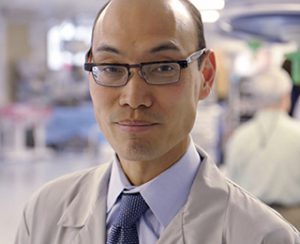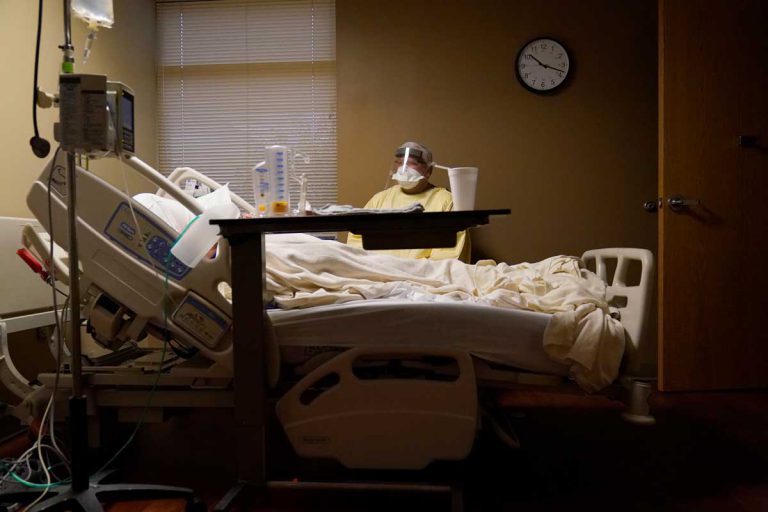EVANSTON – Across Illinois, more than 80% of all ICU beds are now occupied, according to data from the state’s department of public health.
The recent uptick in COVID-19 cases and hospitalizations is raising concerns among state leaders and public health officials about hospitals potentially filling up in the coming weeks.

Dr. Ernest Wang, past-president of the Illinois College of Emergency Physicians, says the state’s second wave is looking like it’s going to be worse than the first.
“A lot of us are seeing higher numbers that look just unbelievable, the way that the curve is going up,” says Wang, who is also the chief of emergency medicine at NorthShore University Health System in Evanston.
Wang spoke with Illinois Newsroom about the situation.
This interview has been lightly edited and condensed for clarity.
Christine Herman: Lately, we’ve been hearing news about hospitals across the country, filling up. Several hospital systems in central Illinois — in areas that didn’t get hit that hard in that first wave the way that the Chicagoland area did — have reported having actually reached full capacity at certain times in recent weeks. What is your sense of whether Illinois hospitals will run out of space? When would that happen, and what would that actually look like?
Dr. Ernest Wang: The number of medical surgical beds is going down. If you look at the state’s public health website, there are fuel gauges on bed availability. And you’re right, the whole state has turned red, if you will, from infection, whereas before, it was mostly in the Chicagoland area. And yeah, I think we’re all concerned about what that’s going to look like over the next couple of weeks.
CH: I imagine there are hard conversations you have to have as a hospital system about what you will do if it comes to that, right? What are some of the questions you’re mulling over in those conversations?
EW: Well, we’re thinking about several things. How do we provide care for not only the COVID patients, but non-COVID patients? Because ethically, you have to be able to treat everybody. And we have to talk about what kinds of cases should we be providing the full extent of care? What patients will this treatment benefit? It becomes a “use-benefit” question. If I’m in a high-risk category, a very severe case, and it doesn’t look like it’s going to be a good outcome, you know, I think there needs to be discussions about what is realistic.
CH: Is the number of patients receiving care in ERs and ICUs right now truly unprecedented? Have Illinois hospitals ever been through anything like this in the recent past?
EW: Not to this extent. And the difference between the second go-around and the first go-around is that, not only are we seeing large numbers of patients coming in with COVID, but people who have non-COVID conditions are still coming in. Whereas in the first wave, they stayed home in general. So that is also taxing the capacity even more.
CH: What is it like for ER doctors and nurses right now, who’ve been running full steam for eight, nine months now with no really clear end in sight? Can you talk about what it’s like to be on the hospital floor?
EW: Yeah, we talk about this a lot. I think a lot of us are tired. This has been going on since March. Even though the end is potentially in sight now; we’re hearing good news about vaccines and so there is hope. And in the scheme of things, I tell people this: compared to the flu pandemic in 1918, which was many years long, this has not even been a year. So I look at it from a glass half full [perspective], but a lot of us are very tired now.
We’re not, I think, as fearful of the disease. We know what it is, what it presents like and how we treat it. And we’re doing a great job of treating it better, and as long as we have the proper PPE, we’re well-protected and we know that now.
But it is hard to watch all the stuff going on, people going out. And you want people to try and socially distance, wear a mask and, you know, there’s so many conflicting messages. Just to watch all the big get-togethers… it’s hard to watch. It is hard to watch.
CH: You mention how hard it is to see people ignoring the public health guidelines, which may be because people are tired of hearing: wear a mask, keep your distance, avoid gatherings. Do you worry people are getting tired of this? And what would you say to someone who feels like: I’m just going to let my guard down, because I’m tired, and I don’t think this is that serious?
EW: Yeah. Well, I say a couple things. Number one, I would say, I understand your point of view, because you’re tired, I’m tired, we’re all tired. Okay. And let’s be real. A rubber band, in its unstretched form, if you stretch it out, there’s tension, and it wants to come back together. And when you separate humans apart from each other for a long period of time, the natural tendency is to come back together. And that’s human nature, that’s the way we are, and that’s okay. So I understand this, and I understand why people would think that way. So that would be my first response.
But once again, you know, I’m reminded that in our country, freedom isn’t free. Freedom isn’t free, except now that instead of soldiers, the freedom that we enjoy — the privilege to freely move about the country, our communities, the ability to not be subject to mandatory mask mandates, to have some personal jurisdiction over that, and to deliberately make personal decisions about wearing a mask — those are being preserved by the healthcare workers, first responders, essential workers. Those are the people risking their lives to preserve those freedoms.
But more importantly, I think the cost is the human lives that have been lost, right? 260,000 lives. And it’s hard to register that number. I worry that it’s just going to be a number that we just kind of watch tick up and up and up. And we don’t think about, you know, what each life meant.
Those that died, you know, in large part, many of them can’t exercise the freedom that we have. They’re the elderly, the sick, the poor, the intergenerational households, minorities, those who can’t escape this exposure.
So that’s why this freedom isn’t free. And if we want to make sure that, you know, our country remains free — if we have any hope of breaking the chain of transmission — we need to acknowledge our own personal obligations.
If you have a question you would like Illinois Newsroom to address regarding COVID-19, submit it here.
Christine Herman is a reporter with Illinois Newsroom. Follow her on Twitter: @CTHerman

